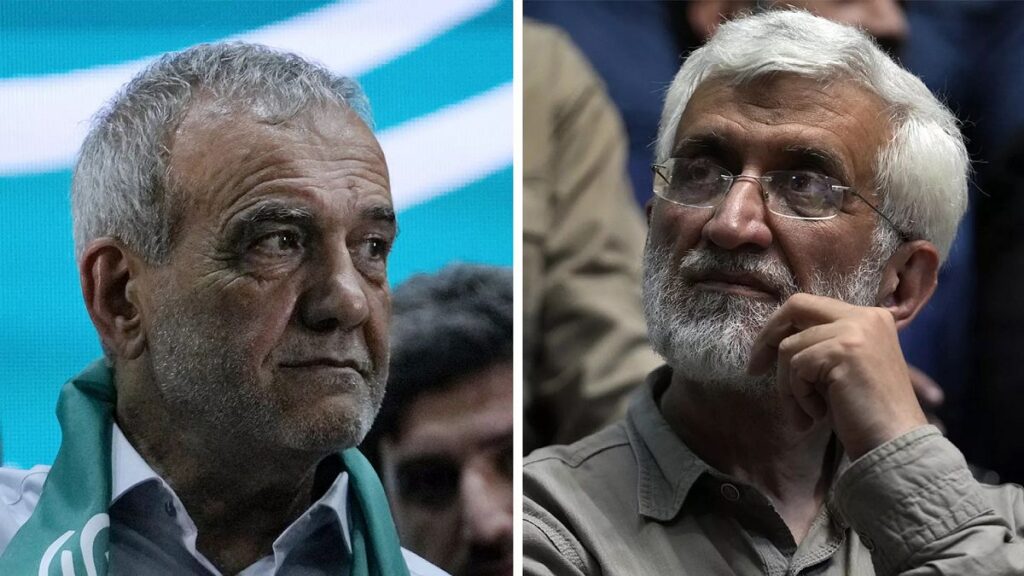Iranians go to the polls this Friday to choose whether reformer Masoud Pezeshkian or ultraconservative Saeed Jalili will succeed the late President Ebrahim Raisi.
After a first round of voting on June 28, which recorded the lowest turnout in the country’s history (39.92%), Iranian voters cast new ballots to decide between two candidates who came out on top last week.
Former nuclear negotiator Saeed Jalili is a hard-line ultraconservative, while Massoud Pezeshkian, a heart surgeon and longtime lawmaker, has allied himself with moderates and reformists in Iran’s Shiite theocracy.
After years of economic struggle, mass protests and tensions, public apathy towards politics has become pervasive in the Islamic Republic of Iran.
Calls for a boycott of the elections have also been made.including by Nobel Peace Prize winner Narges Mohammadi, currently in prison.
What is the role of the Iranian president?
In Iran, most power is concentrated in the hands of the Supreme Leader, Ayatollah Ali Khamenei.
But It is the president’s responsibility to lead the government and travel abroad to meet with his counterparts..
As has been the case since the Islamic Revolution of 1979, Women and those calling for radical change were excluded from the votewhile the vote itself is not subject to any control by international observers.
A crucial election in a difficult period
The vote takes place in Middle East tense as Gaza conflict continuesIn April, attacks by militias armed by Tehran – such as Lebanon’s Hezbollah and Yemen’s Houthi rebels – contributed to the escalation of the war between Israel and Hamas.
During this time, Iran continues to enrich uranium and maintains a stockpile large enough to build multiple nuclear weapons if it so desires..
The 2015 nuclear deal with world powers, brokered by officials who now support Massoud Pezeshkian, collapsed in 2018 after then-President Donald Trump abruptly decided to withdraw the United States from the accord.
Since then, Hardliners have taken power in the Iranian government.
Ali Khamenei, who was one of the first to vote from his residence, said that Those who abstained last week were not necessarily opposed to the country’s Shiite theocracy.
“I heard that people’s enthusiasm is greater than before”the Ayatollah said. “God willing, people will vote and choose the best candidate”.
How far will Iran’s hard line go if Said Jalili is elected?
More than 61 million Iranians aged 18 and over are eligible to vote, including around 18 million under 30. Elections are scheduled to close at 6pm local time, but polling stations often stay open until midnight to encourage turnout..
This is only the second time that a second round of presidential elections has been held in Iran since 1979.
The first was in 2005, when Mahmoud Ahmadinejad, a hardliner, defeated former President Akbar Hashemi Rafsanjani. Under Ahmadinejad, Iran faced international sanctions in response to its advancing nuclear program, as well as the 2009 Green Movement protests and the crackdown that crushed them.
Supporters of Massoud Pezeshkian have warned of a “Taliban”-style government in Tehran if Said Jalili is elected; the latter has criticized his opponent for leading a campaign of incitement to fear.
The Death and Legacy of Ebrahim Raïssi
Aged 63, Ebrahim Raisi died in a helicopter crash on May 19, which also claimed the lives of the country’s foreign minister and several other passengers.He was seen as a protégé of Khamenei and a potential successor to the supreme leader.
However, he was known to many for his involvement in Iran’s mass executions in 1988 and for his role in the bloody crackdown on dissidents that followed protests over the 2022 death of Mahsa Amini, a young woman detained by police for allegedly improperly wearing the mandatory headscarf, or hijab.


